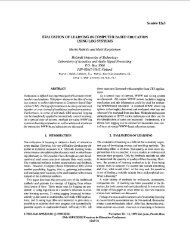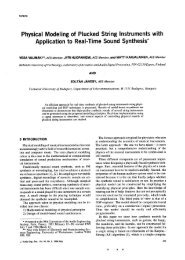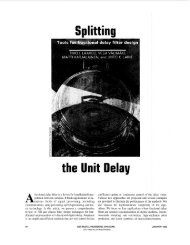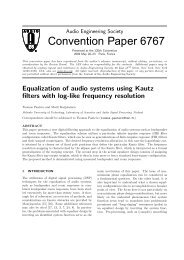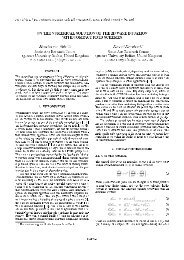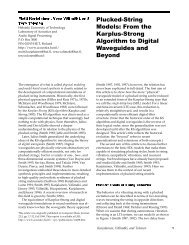A computationally efficient multipitch analysis model ... - IEEE Xplore
A computationally efficient multipitch analysis model ... - IEEE Xplore
A computationally efficient multipitch analysis model ... - IEEE Xplore
You also want an ePaper? Increase the reach of your titles
YUMPU automatically turns print PDFs into web optimized ePapers that Google loves.
TOLONEN AND KARJALAINEN: COMPUTATIONALLY EFFICIENT MULTIPITCH ANALYSIS MODEL 709Fig. 1. Block diagram of the Meddis–O’Mard <strong>model</strong> [17].The paper is organized as follows. In Section II, the proposedpitch <strong>analysis</strong> <strong>model</strong> is introduced and compared to pitch perception<strong>model</strong>s reported in the literature. Section III describeshow the periodicity representation can be enhanced so that periodicitiesmay be more easily investigated. Section IV discussesthe <strong>model</strong> parameters and shows with examples how they affectthe behavior of the <strong>model</strong>, and Section V demonstrates the<strong>model</strong> performance in <strong>multipitch</strong> determination. Finally, SectionVI concludes the paper with a summary and discussion.II. PITCH ANALYSIS MODELA. Multichannel Pitch AnalysisIn many recent <strong>model</strong>s of human perception, the key componentis a filterbank that simulates the behavior of the cochlea.The filterbank separates a sound signal into subband channelsthat have bandwidths corresponding to the frequency resolutionof the cochlea. A common choice is to use a gammatone filterbank[22] with channels corresponding to the equivalent rectangularbandwidth (ERB) channels of human audition [23].Fig. 1 depicts the pitch perception <strong>model</strong> of Meddis andO’Mard [17] that uses the filterbank approach. The inputsignal is first divided into 40–128 channels depending on theimplementation [16], [17], [21]. The signal in each channel ishalf-wave rectified and lowpass filtered. Essentially, this stepcorresponds to the detection of the envelope of the signal ineach channel. From the envelope signals, a periodicity measure,such as the autocorrelation function (ACF), is computedwithin each channel. Finally, the ACFs are summed across thechannels to yield a summary autocorrelation function (SAFC)that is used in pitch <strong>analysis</strong>.In studies that have applied the pitch <strong>analysis</strong> paradigm ofFig. 1, several implementations are reported. In some systems,pre-processing of the signal is performed before the signalenters the filterbank. For instance, in [17] a bandpass filter isused for simulating the middle ear transfer function. In [17] thehalf-wave rectification and lowpass filtering block is replacedwith a block that estimates the probability of neural activationin each channel. In [24], an automatic gain control block isadded after the half-wave rectification and the lowpass filteringis removed.There are several approaches for computation of the autocorrelationor a similar periodicity measure within each of the channels.The time domain approach is a common choice [16], [17],[21]. In these systems, an exponential window is applied witha window time constant that varies from 2.5 ms [17] to 25 ms[21]. Our experiments have determined that the effective lengthof the window should be approximately 10–30 ms so that thewindow spans more than one period of the pitched tone with allfundamental periods that are in the range of interest. Ellis [21]applies a logarithmic scale of the autocorrelation lag with approximately48 samples for each octave. He motivates the useof such a scale by better resemblance with the pitch detectionresolution of the human auditory system. This requires interpolationof the signals in the channels. Ellis notes that half-waverectification is preferred over full-wave rectification in order tosuppress octave errors.Some of the pitch <strong>analysis</strong> systems prefer to use a discreteFourier transform (DFT) based autocorrelation computation forcomputational efficiency [24]. This approach also allows forprocessing of the signal in the frequency-domain. As discussedbelow, nonlinear compression of the DFT magnitude may beused to enhance the performance of the pitch <strong>analysis</strong>. Sucha compression is not readily implementable in a time-domainsystem.Although the unitary pitch perception <strong>model</strong> of Meddis andO’Mard has been widely adopted, some studies question thegeneral validity of the unitary pitch perception paradigm. Particularly,it has been suggested that two mechanisms for pitchperception are required: one for resolved harmonics and one forunresolved harmonics [25], [26]. The term resolved harmonicsrefers to the case when only one or no components fall within the10-dB-down bandwidth of an auditory filter [27]. In the othercase, the components are said to be unresolved. The presentstudy does not attempt to answer the question on the pitch detectionmechanism of the human auditory system. In fact, theproposed <strong>model</strong> has only two channels and does not attempt directlyto follow human resolvability. Interestingly enough, asshown in the following subsection, the <strong>model</strong> still qualitativelyproduces similar and comparable results to those of the moreelaborate multichannel pitch <strong>analysis</strong> systems.The computational demands of multichannel pitch <strong>analysis</strong>systems have prohibited their use in practical applications wheretypically real-time performance is required. The computationalrequirements are mostly determined by the number of channelsused in the filterbank. This motivates the development of a simplified<strong>model</strong> of pitch perception presented below that is moresuitable in practical applications and still qualitatively retainsthe performance of multichannel systems.B. Two-Channel Pitch AnalysisA block diagram of the proposed two-channel pitch <strong>analysis</strong><strong>model</strong> is illustrated in Fig. 2. The first block is a pre-whiteningfilter that is used to remove short-time correlation of thesignal. The whitening filter is implemented using warped linearprediction (WLP) as described in [28]. The WLP techniqueworks as ordinary linear prediction except that it implementscritical-band auditory resolution of spectral <strong>model</strong>ing insteadof uniform frequency resolution, and can be used to reduce the







